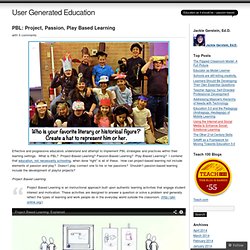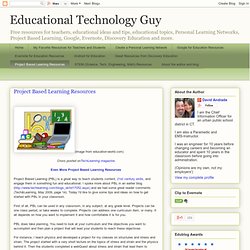

Project-Based, Problem-Based, or Inquiry-Based Learning? NMHS_Principal: Translating #math problems... 7 Tools Students Can Use to Manage Group Projects. BiancaH80: If you're interested in Pr... CBLHome. Welcome to an introduction to implementing Challenge Based Learning in UK schools. Many of the resources on these pages are based on those provided by Apple on the main CLB site at and have just been adapted to a UK perspective.
Others are extra challenges to give more choice to you, the teacher. We begin with a brief introduction to CBL and then the challenges. There is then a discussion group for each challenge for you to share how the challenges have worked for you and to suggest how I might improve the resources. If you want to suggest or contribute new challenges, you can download a challenge template in Pages (and Word) or simply send the information to me via email at simon_elliott@me.com All resources on this site are copyright to me and available under a Creative Commons Share-a-Like licence, except where copyright or intellectual property resides with Apple Inc. or Mounts Bay Academy.
Beyond Googling: Using Tech to Build Culture of Inquiry by Chris Lehman. GoogletoCultureofInquiry.png. Digital Tools for Project-Based Learning in Primary. Suzie Boss and Jane Krauss's book Reinventing Project Based Learning is a wealth of information about digital tools, the internet and Web 2.0 and how these tools can be used to meet the essential learning needs of 21st century students.

Here are some ideas taken from Chapter 3 of the book, all of which I've used with primary students and which I have tried to align with the new ICT in the PYP strands. The need for ubiquity - ICT in the PYP strand: Investigate, Communicate Today's students want to be able to learn any time and anywhere. Making Projects Click. Teacher's Guide to Project-based Learning.pdf. Our New Family Project ... - Off We Go Exploring and Wondering .... PBL: Project, Passion, Play Based Learning. Effective and progressive educators understand and attempt to implement PBL strategies and practices within their learning settings.

What is PBL? Project-Based Learning? Passion-Based Learning? Play-Based Learning? I contend that education, not necessarily schooling, when done “right” is all of these. Why I Love Project Based Learning. I love project-based learning.

Why? Because my students do. Some of my favourite PBL adventures are the Biology 30 projects due at semester’s end. These aren’t the only projects we pursue throughout the semester; we also work on a number of digital creations. However, these tend to be the most intricate and hands-on. For the past week, my students have been sharing their projects. The topic for this particular biology activity was body systems. One of my students created a Monopoly-type board game based on the nervous system. But the best part of his presentation, to me, was when he stated: “I really enjoyed doing this. Another student researched and created a model of the knee. A third student created two cakes (shown below) — each depicting a brain state. And this is yet another reason PBL can be powerful. This particular student chose this topic because her family has been deeply and painfully affected by depression.
We also learned about hip replacements. About the author. Students Redesign Their Own Schools. Student-designed school bus shelter. By Chris Thompson Up until a couple of years ago, the Chicago Architecture Foundation’s strategies were pretty ordinary: tours of interesting buildings around Chicago, or publishing a high school architecture textbook. But the foundation staff wanted to do try more interesting, a project that would compel students to really be immersed in the world of architecture and to solve a problem. They came up with DiscoverDesign, challenging students to redesign their schools, one piece at a time. Start with their lockers. “A teenager doesn’t have much experience in a skyscraper,” says Jen Masengarb, the Foundation’s senior manager for educational research. Working under a teacher, students around the country have begun conceptualizing, redesigning, and ultimately submitting drafts for a variety of school functions: lockers, cafeterias, bike stands – even an entire technology wing.
The projects stimulate three essential areas of learning. Related. Project Based Learning: Explained. Project Based Learning. (image from education-world.com) Project Based Learning (PBL) is a great way to teach students content, 21st century skills, and engage them in something fun and educational.

I spoke more about PBL in an earlier blog ( and we had some great reader comments (Tech&Learning, May 2009, page 14). Today I'd like to give some tips and ideas on how to get started with PBL in your classroom. First of all, PBL can be used in any classroom, in any subject, at any grade level. Projects can be one class period, or take weeks to complete. Free Project Based Learning Resources from Edutopia. Edutopia, the George Lucas Educational Foundation, is an excellent resource for educators.

Their site has a huge variety of resources, tips, and research on education and is accessible for free. They are a big proponent of Project Based Learning (PBL) and also have a lot of resources on best practices in education. Resources include lists of reading materials on PBL, links to schools that are using PBL, Resources from Edutopia on PBL, Resources from Maine on PBL including examples of PBL, lesson plans, assessments for PBL, planning guides for teachers and schools, professional development resources, resources for parents, and links to organizations and other resources on PBL. Flattening the School Walls.
Can Six Year Olds Really Demonstrate Their Learning? By Kathy Cassidy This week we finished up another one of our project based learning (PBL) or inquiry-based units in my first grade classroom.

It had the grand title of rules, relationships and responsibilities. Why I Let Students Take the Lead in Learning Demonstration At the end of each of our units, I have the students create an artifact that can be posted on their blog to show what each of them has learned about our topic of study. I have never been a big supporter of “tests”, especially in first grade, where the students are usually much more comfortable showing learning in a verbal way rather than a written one.
Even as young as six years old, students begin to realize that they are stronger in some areas than others. An Introduction to Project-Based Learning.